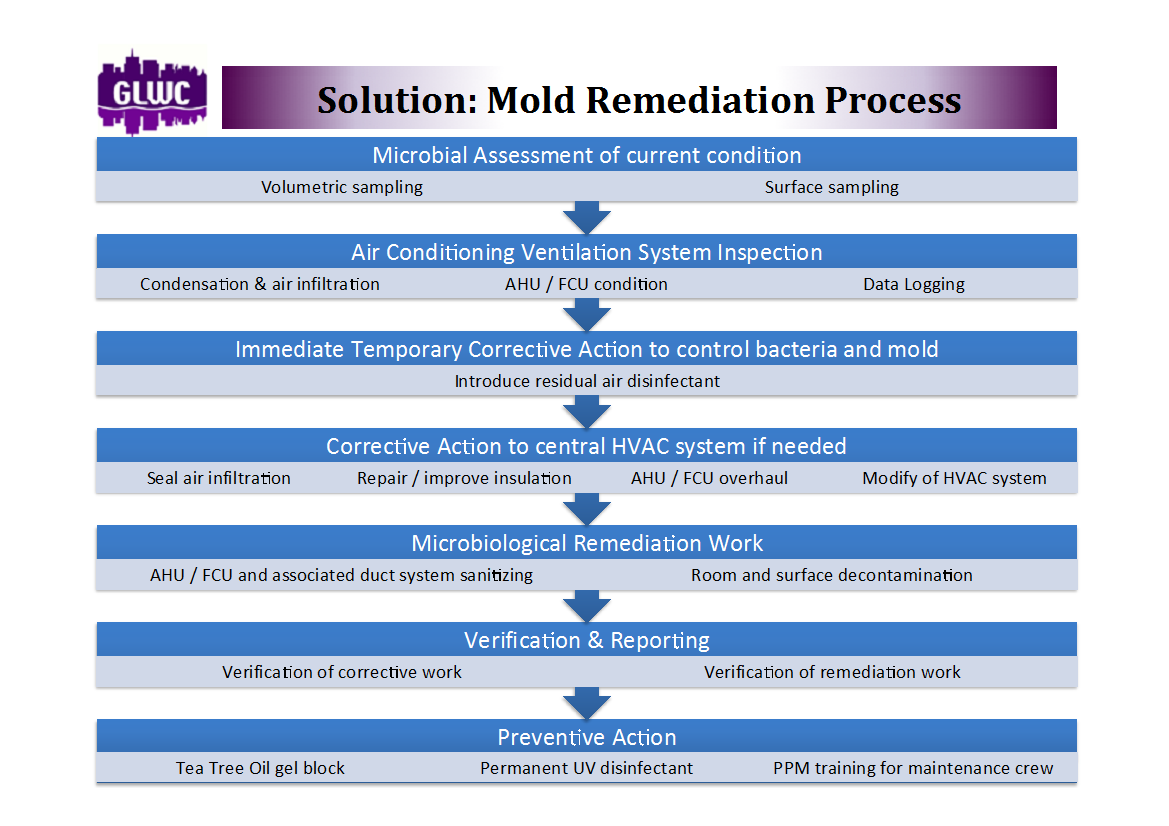Mold Remediation: Our Experience


Air sampling results prior and post decontamination activities. Bacteria and fungus count limits: 500 cfu/m³ for general indoor areas. All relevant limits were achieved after decontamination.
Mold Remediation at Administrative Office Building, Malaysia
Project: Mold-decontamination at administrative office building
Time: August – September 2011
Building: Built in 1976; number of floors: 22
Building condition: Mold and moisture problems on almost every floor, mostly due to condensation from fresh air intrusion into air-conditioned space plus from water seepage through ceiling and walls. Biggest issue: mold on executive floors.
Job scope under GLWC: IAQ testing, Root cause analysis, Mold decontamination, Rectification of root causes for mold.
GLWC staff during air sampling, root cause analysis and mold decontamination works, August 2011
Hospital Mold Remediation & Disinfection, Malaysia
Project: Mold-decontamination and disinfection of newly commissioned hospital with 42,000 m² total floor area
Time: December 2010 – March 2011
Building: Built in 2006 as private hospital with several building blocks to cater for everything a hospital needs.
Total floor area: 42,000 m². This includes all the medical departments with 6 operating theatres, ICU, central sterile storage, ward blocks etc. Further it includes canteen, engineering, admin and so forth.
Building condition: Building had not been in use for nearly 4 years until renovations started in 2010 to become a public hospital.
Job scope under GLWC: Comprehensive IAQ testing, Mapping and tracking of all mold occurrences and water damage, Root cause analysis, Comprehensive mold decontamination, Sterilization of all rooms, Rectification of root causes for mold.
The job was followed by maintenance contracts for all AHUs / FCUs plus the air-con water treatment.
GLWC team during mold clean-up works including vacuuming with HEPA vacuum cleaner, wiping with hospital grade disinfectant and misting with tea-tree oil based disinfectant, January 2011


Air sampling results prior and post decontamination activities. Bacteria and fungus count limits: 500 cfu/m³ (general areas), 35 cfu/m³ (specialty areas highlighted in circles). All relevant limits were achieved after decontamination.
Mold Remediation: The Process
Mold remediation is the most obvious step in resolving a mold problem. It is a complex process that needs to be planned carefully, and it has to be part of an overall mold-prevention strategy for which the root cause analysis is essential. If not done well, mold can quickly reoccur after the remediation efforts are finished. Therefore it is important to choose a service provider who is experienced and who takes the time to understand the specific site conditions.
Some service providers use toxic chemicals to kill mold. While this may be effective in removing mold, it can be detrimental to the health of contractors and also building users after the mold remediation. At GLWC, we believe in using green, plant-based chemicals that are non-harmful to humans: better for our team, better for future building users, better for the environment, and most important of all: very effective in removing mold!
The Overview
The following illustrations highlight the stages and elements of the mold remediation procedure.



If you think your facility may require help from IAQ experts, please don’t hesitate to contact us.
